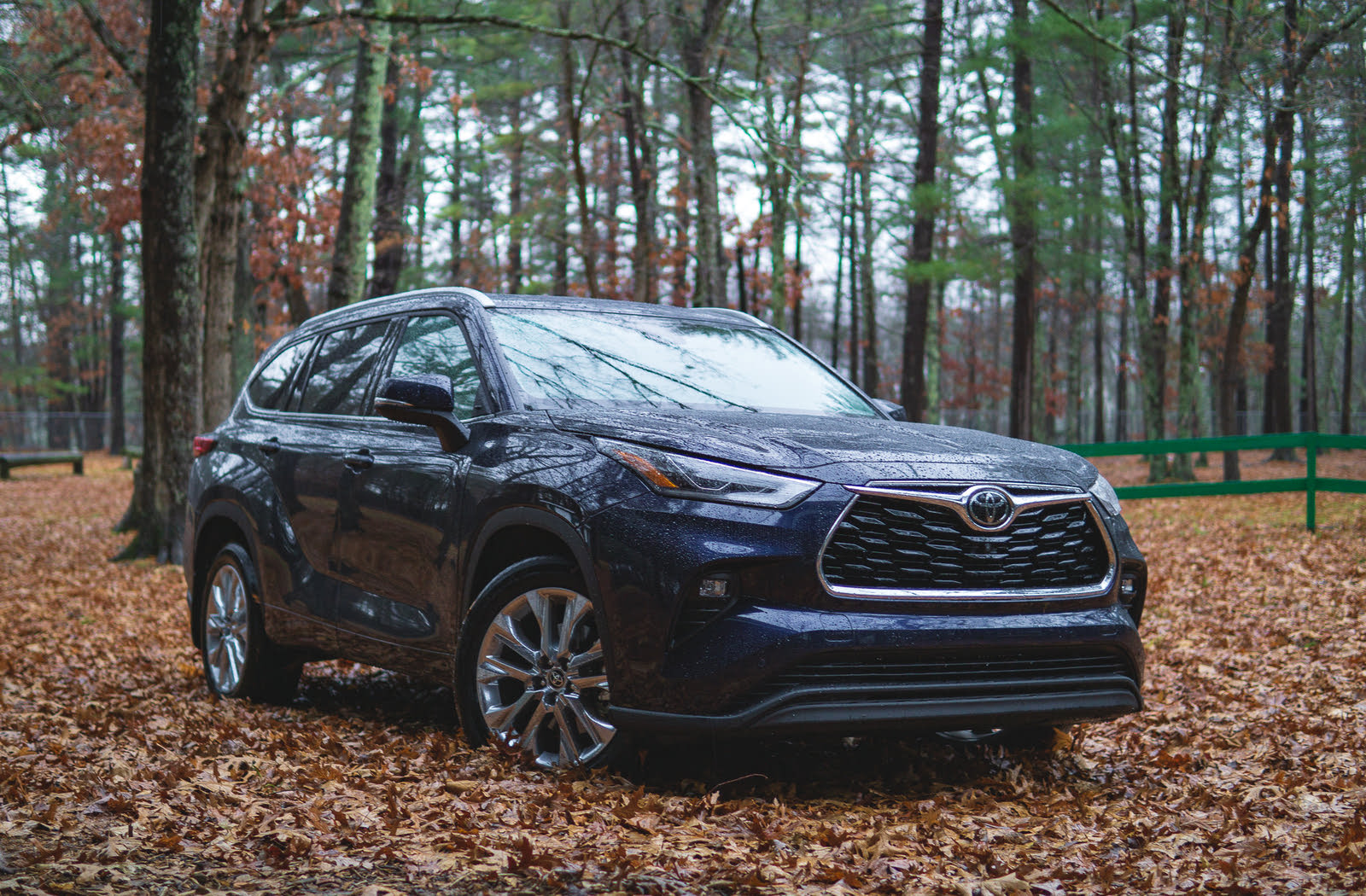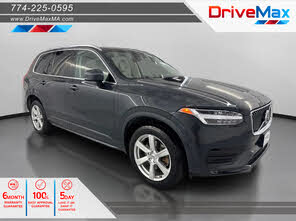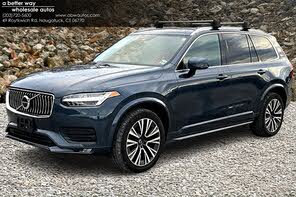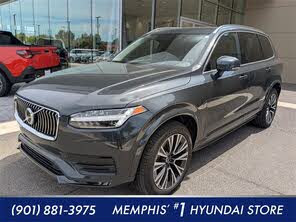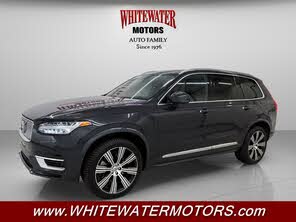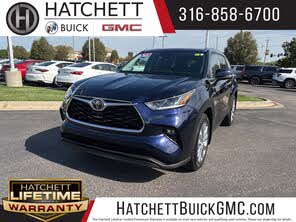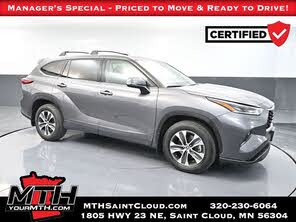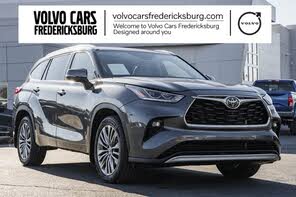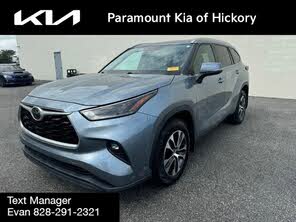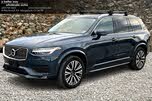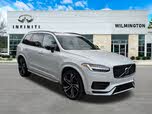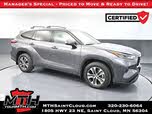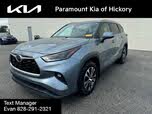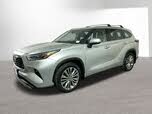2021 Volvo XC90 vs 2021 Toyota Highlander
Overview | |
MSRP$49,000 | MSRP$35,085 |
Listings320 | Listings1485 |
Ratings & Reviews | |
User Reviews | User Reviews |
Expert reviews7.7 out of 10 | Expert reviews7.5 out of 10 |
Pros
Cons
| Pros
Cons
|
2021 Volvo XC90 Reviews SummaryVolvo may be known for sensible station wagons, but the XC90 SUV is the Swedish automaker’s de facto flagship. The current generation debuted design features, technology, and powertrains that have since found their way into most other Volvo models. Several years into the current-generation model’s lifecycle, the XC90 is no longer a trendsetter, but remains Volvo’s contender in the competitive midsize luxury SUV segment, with the automaker’s typical emphasis on safety features. The current-generation XC90 launched for the 2016 model year, so most competitors—including the Audi Q7, Acura MDX, BMW X5, and Mercedes-Benz GLE-Class—have been updated or redesigned since then. The Cadillac XT6 and Lincoln Aviator didn’t even exist when this generation of XC90 launched. A redesigned version is expected to arrive soon, so changes to the 2021 XC90 are minimal. All 2021 Volvo models are now limited to 112 mph for safety reasons and get Care Key, which lets owners limit the top speed before loaning the car out to a friend or family member. The XC90 also gets a handful of newly standard tech features, and some small cosmetic changes. Volvo offers the XC90 in three trim levels—Momentum, R-Design, and Inscription—with three powertrain options: T5 and T6 gasoline engines, and the T8 plug-in hybrid. Our test car was a range-topping T8 Recharge Inscription, combining the top Inscription trim level with the plug-in hybrid powertrain, which has the highest output of the three. | |
2021 Toyota Highlander Reviews SummaryToyota hardly needs any help selling three-row Highlanders. It already sits close to the top of the sales charts for its segment, and few vehicles carry the name recognition as the Highlander, which enters into its 20th year of production. But the three-row marketplace is a competitive one, and even after a 2020 redesign, Toyota would be foolish to rest on its laurels. As such, the Highlander enters this year with additional safety-feature technology listed as standard equipment. | |
No video found | |
Popular Features & Specs | |
Engine2.0L 250 hp I4 | Engine3.5L 295 hp V6 |
Drive TrainFWD | Drive TrainFWD |
Seating Capacity7 | Seating Capacity8 |
Horsepower250 hp @ 5500 rpm | Horsepower295 hp @ 6600 rpm |
MPG City21 | MPG City20 |
MPG Highway30 | MPG Highway28 |
Engine | |
Engine Name2.0L 250 hp I4 | Engine Name3.5L 295 hp V6 |
Torque258 lb-ft @ 1500 rpm | Torque263 lb-ft @ 4700 rpm |
Horsepower250 hp @ 5500 rpm | Horsepower295 hp @ 6600 rpm |
DrivetrainFWD | DrivetrainFWD |
Fuel Economy | |
MPG City21 | MPG City20 |
MPG Highway30 | MPG Highway28 |
Interior | |
Seating Capacity7 | Seating Capacity8 |
Key Features | |
Sunroof/MoonroofStandard | Sunroof/Moonroof |
Safety | |
Front Crash Overall5 | Front Crash Overall4 |
Side Crash Overall5 | Side Crash Overall5 |
Dimensions & Capacity | |
Cargo Space10.7 cu ft | Cargo Space16.0 cu ft |
Curb Weight4374 lbs | Curb Weight4145 lbs |
Height69.9 in | Height68.1 in |
Length195.0 in | Length194.9 in |
Width84.3 in | Width76.0 in |
Wheelbase117.5 in | Wheelbase112.2 in |
Maximum Payload1631 lbs | Maximum Payload1685 lbs |
Number of doors4 | Number of doors4 |
Maximum Towing Capacity4000 lbs | Maximum Towing Capacity5000 lbs |
Overview | ||
MSRP | $49,000 | $35,085 |
Listings | ||
Ratings & Reviews | ||
User reviews | ||
Expert reviews | 7.7 out of 10Read full review | 7.5 out of 10Read full review |
Pros & cons | Pros
Cons
| Pros
Cons
|
Summary | Volvo may be known for sensible station wagons, but the XC90 SUV is the Swedish automaker’s de facto flagship. The current generation debuted design features, technology, and powertrains that have since found their way into most other Volvo models. Several years into the current-generation model’s lifecycle, the XC90 is no longer a trendsetter, but remains Volvo’s contender in the competitive midsize luxury SUV segment, with the automaker’s typical emphasis on safety features. The current-generation XC90 launched for the 2016 model year, so most competitors—including the Audi Q7, Acura MDX, BMW X5, and Mercedes-Benz GLE-Class—have been updated or redesigned since then. The Cadillac XT6 and Lincoln Aviator didn’t even exist when this generation of XC90 launched. A redesigned version is expected to arrive soon, so changes to the 2021 XC90 are minimal. All 2021 Volvo models are now limited to 112 mph for safety reasons and get Care Key, which lets owners limit the top speed before loaning the car out to a friend or family member. The XC90 also gets a handful of newly standard tech features, and some small cosmetic changes. Volvo offers the XC90 in three trim levels—Momentum, R-Design, and Inscription—with three powertrain options: T5 and T6 gasoline engines, and the T8 plug-in hybrid. Our test car was a range-topping T8 Recharge Inscription, combining the top Inscription trim level with the plug-in hybrid powertrain, which has the highest output of the three. | Toyota hardly needs any help selling three-row Highlanders. It already sits close to the top of the sales charts for its segment, and few vehicles carry the name recognition as the Highlander, which enters into its 20th year of production. But the three-row marketplace is a competitive one, and even after a 2020 redesign, Toyota would be foolish to rest on its laurels. As such, the Highlander enters this year with additional safety-feature technology listed as standard equipment. |
Video | No video found | |
Popular Features & Specs | ||
Engine | 2.0L 250 hp I4 | 3.5L 295 hp V6 |
Drive Train | FWD | FWD |
Seating Capacity | 7 | 8 |
Horsepower | 250 hp @ 5500 rpm | 295 hp @ 6600 rpm |
MPG City | 21 | 20 |
MPG Highway | 30 | 28 |
Engine | ||
Engine Name | 2.0L 250 hp I4 | 3.5L 295 hp V6 |
Torque | 258 lb-ft @ 1500 rpm | 263 lb-ft @ 4700 rpm |
Horsepower | 250 hp @ 5500 rpm | 295 hp @ 6600 rpm |
Drivetrain | FWD | FWD |
Fuel Economy | ||
MPG City | 21 | 20 |
MPG Highway | 30 | 28 |
Interior | ||
Seating Capacity | 7 | 8 |
Key Features | ||
Sunroof/Moonroof | Standard | |
Safety | ||
Front Crash Overall | 5 | 4 |
Side Crash Overall | 5 | 5 |
Dimensions & Capacity | ||
Cargo Space | 10.7 cu ft | 16.0 cu ft |
Curb Weight | 4374 lbs | 4145 lbs |
Height | 69.9 in | 68.1 in |
Length | 195.0 in | 194.9 in |
Width | 84.3 in | 76.0 in |
Wheelbase | 117.5 in | 112.2 in |
Maximum Payload | 1631 lbs | 1685 lbs |
Number of doors | 4 | 4 |
Maximum Towing Capacity | 4000 lbs | 5000 lbs |
The 2021 Volvo XC90 achieved a remarkable transformation in design since its 2016 generation. Traditionally known for conservative styling, Volvo managed to reinvigorate its image by adding character while staying true to its roots. The XC90 retained Volvo's classic boxy profile and blunt front end crowned with a rectangular grille. However, softer lines, additional chrome, and distinctive LED headlights featuring “Thor’s Hammer” daytime running lights set it apart.
The XC90 Inscription trim, the flashiest among the available trims, sported extra chrome and optional 21-inch alloy wheels. In contrast, the R-Design aimed for a sportier aesthetic with gloss-black grille surroundings, while the base Momentum trim remained understated. The Momentum came with standard 19-inch wheels but sported a new design for 2021, and the R-Design boasted 20-inch wheels.
Built on Volvo’s Scalable Product Architecture (SPA) platform, the XC90 shared its underpinnings with other "90" and "60" series models, establishing common ground with the S90 sedan and XC60 crossover. Inside, "Swedish minimalism" aptly described the XC90’s interior. The atmosphere was one of elegance without excessive flair, featuring matte-finish wood trim and even an option for wool upholstery. Nappa leather was also available. Although the Orrefors crystal shifter added a high-end touch, it seemed somewhat out of place amidst the otherwise restrained interior.
In comparison, the 2021 Toyota Highlander could hardly be called boring. It stood out with wide headlights, a long hood, and an assertive trapezoidal grille, making a statement even among the midsize SUV crowd. It carried a character line akin to that of the Supra sports car, and taillights reminiscent of Lexus models, albeit minus the vertical element. The 2021 Highlander appeared longer and lower than its predecessor, maintaining its size but altering its visual profile.
The newly introduced XSE trim level featured an aggressive front end design and appearance package, enabling it to masquerade as a sportier variant. However, the sporty claim was more aesthetic than performance-based. The Limited trim, just below the top-tier Platinum, offered chrome roof rails and accents, giving the Highlander an upscale look. Inside, the Limited trim excelled in fit and finish, featuring tan leather seats and dark brown trim. The fake wood details were visually appealing, even if not genuine.
The Highlander leaned toward luxury in its practical approach, focusing on comfort and convenience over sportiness.

















For the 2021 Volvo XC90, performance was defined through its three available powertrains, all featuring a 2.0-liter four-cylinder engine mated to an eight-speed automatic transmission. The base T5 offered a turbocharged version of this engine, producing 250 horsepower and 258 pound-feet of torque. The T6 enhanced performance with both turbocharging and supercharging, generating 316 horsepower and 295 pound-feet of torque.
The T8 Twin Engine plug-in hybrid, branded as Recharge, combined the T6 engine with an electric motor, delivering a formidable 400 horsepower and 472 pound-feet of torque. The T5 was available with front-wheel drive (FWD) as standard, with an all-wheel-drive (AWD) option. AWD was standard on the T6 and T8.
Despite the potent 400 horsepower output, the small four-cylinder engine had limitations, particularly in acceleration at low speeds, where the gasoline engine often had to assist. The XC90 offered three driving modes—Pure, Hybrid, and Power—but the all-electric Pure mode was best suited for low speeds and gentle acceleration.
The XC90 excelled in ride quality, aided by an optional air-suspension system, maintaining comfort with minimal body roll around corners. It also boasted a respectable 5,000-pound towing capacity (4,000 pounds for the FWD T5), though it fell short of competitors like the Lincoln Aviator’s 6,700-pound rating.
The 2021 Toyota Highlander, in contrast, housed a 3.5-liter V6 engine producing 295 horsepower and 263 pound-feet of torque. This engine was paired with an eight-speed automatic transmission, driving either the front or all four wheels. The Highlander didn’t aim to be a performance powerhouse but offered a smooth and reliable driving experience. It equaled the likes of the Kia Telluride and Hyundai Palisade in power, though the Mazda CX-9 outperformed it in torque.
Designed as a family vehicle, the Highlander did "lumber" a bit through corners, which was expected due to its soft suspension tuned more for comfort than agility. The XSE trim added suspension tuning, including higher-rated springs, retuned shocks, and a rear stabilizer bar, providing a touch of sportiness without transforming it into a performance SUV.
The Volvo XC90 offered a three-row seating arrangement, available in six- or seven-seat configurations. Headroom and legroom were average for the segment, with the third-row seats being somewhat tight for adults. Seats in the second and third rows were harder and less supportive than desired. The interior’s spacious feel was enhanced by an optional power moonroof spanning the first two rows.
The range-topping Inscription trim featured 10-way power-adjustable heated and ventilated front seats with backrest massage, but lacked a power-adjustable steering wheel, which was a notable omission. Storage space was limited, with a shallow center console storage bin and few storage options on the console itself.
Regarding cargo capacity, the XC90 T8 Recharge offered 11.2 cubic feet with all seats in place, 34.1 cubic feet with the rear seats folded, and 64.1 cubic feet with both second and third rows folded, placing it near the bottom of the segment. Cargo space with the third row in use was particularly limited. However, Volvo’s hands-free power tailgate added convenience.
The Toyota Highlander, focused on family comfort, featured practical shelves ahead of the front seats, large enough to house even the largest phones with a pass-through for charging cords. Second-row passengers enjoyed ample legroom with seats that moved forward and backward to maximize space or grant additional legroom to third-row occupants. However, rear-seat climate control vents were ceiling-mounted, blowing directly down on middle-row passengers’ heads, which was less than ideal.
Cargo space in the Highlander surpassed the XC90, offering 16 cubic feet behind the third row, 48.4 cubic feet with the third row folded, and 84.3 cubic feet with the second and third rows folded. This made it a more practical choice for carrying luggage and larger loads compared to the XC90.
Volvo’s Sensus infotainment system in the 2021 XC90 demonstrated that less can indeed be more. The standard 9-inch touchscreen was user-friendly, augmented by a 12.3-inch digital instrument cluster, Apple CarPlay/Android Auto compatibility, Bluetooth, and a built-in WiFi hotspot. It also featured two front USB-A ports and two rear USB-C ports. A 19-speaker Bowers & Wilkins premium audio system and a head-up display (HUD) were optional.
The portrait-oriented touchscreen was one of the best, functioning smoothly like a tablet. However, the text-heavy menus and specific typeface created readability issues while driving. The newly added wireless charging pad was limited in size, and the lack of USB-C ports up front posed a challenge for drivers with newer phones.
On the 2021 Toyota Highlander, lower trims included an 8-inch touchscreen, with a 12.3-inch screen available on the Limited trim as an option and standard on the Platinum. The larger screen in our test vehicle was bright, crisp, and quick. It included standard Android Auto and Apple CarPlay across all trims.
Navigation, however, was an added-cost option and had limitations. It handled specific addresses well but struggled with points of interest that Google Maps easily located. The JBL audio system, available with the larger screen, sounded decent but didn’t impress significantly. Apps on the big screen were also limited to an 8-inch display space, questioning the value of the larger screen's extra cost.
Living up to Volvo’s reputation, the 2021 XC90 earned the highest “Top Safety Pick+” rating from the IIHS, although this rating did not extend to the plug-in hybrid T8 model. It received top “Good” scores and the highest “Superior” rating for front-crash prevention, alongside an “Advanced” rating for pedestrian detection.
Standard safety features were extensive, including lane-keep assist, driver-attention monitor, traffic-sign recognition, blind-spot monitoring, rear cross-traffic alert, automatic emergency braking, and Volvo’s Pilot Assist, which combined adaptive cruise control with automated lane centering. While Pilot Assist wasn’t flawless, particularly on highway curves, it remained one of the best systems available.
The 2021 Toyota Highlander stepped up with an upgraded safety suite, Toyota Safety Sense 2.5+ (TSS 2.5+). This included automatic emergency braking with pedestrian detection and intersection support—a technology that could preemptively engage the emergency braking system. The suite also incorporated road-sign assist, adaptive cruise control, lane-departure warning, lane-keeping assist, lane-tracing assist, and automatic high beams.
The Highlander earned a five-star overall safety rating from the NHTSA and a Top Safety Pick+ from the IIHS, making it one of the safest choices in its category.
CarGurus highlights

According to CarGurus experts, the overall rating for the 2021 Volvo XC90 is 7.7 out of 10, while the 2021 Toyota Highlander scores 7.5 out of 10. Based on these ratings, the Volvo XC90 narrowly comes out on top. For families seeking a premium, safety-focused SUV with a touch of Swedish design flair, the Volvo XC90 is the recommended choice. However, those needing greater cargo space and excellent reliability from a well-known brand will find the Toyota Highlander a formidable competitor.
Choose the 2021 Volvo XC90 if:
- * You prioritize a luxurious, minimalist interior with high-quality materials.* You want a comprehensive suite of advanced safety features and Pilot Assist.* You appreciate a blend of traditional Volvo styling with modern design elements.
Choose the 2021 Toyota Highlander if:
- * You need more cargo space for family trips and activities.* You value a proven, reliable V6 engine with smooth operation.* You desire a comprehensive set of standard safety features and excellent safety ratings.
CarGurus highlights

According to CarGurus experts, the overall rating for the 2021 Volvo XC90 is 7.7 out of 10, while the 2021 Toyota Highlander scores 7.5 out of 10. Based on these ratings, the Volvo XC90 narrowly comes out on top. For families seeking a premium, safety-focused SUV with a touch of Swedish design flair, the Volvo XC90 is the recommended choice. However, those needing greater cargo space and excellent reliability from a well-known brand will find the Toyota Highlander a formidable competitor.
Choose the 2021 Volvo XC90 if:
Shop Now- * You prioritize a luxurious, minimalist interior with high-quality materials.* You want a comprehensive suite of advanced safety features and Pilot Assist.* You appreciate a blend of traditional Volvo styling with modern design elements.
Choose the 2021 Toyota Highlander if:
Shop Now- * You need more cargo space for family trips and activities.* You value a proven, reliable V6 engine with smooth operation.* You desire a comprehensive set of standard safety features and excellent safety ratings.

By: CarGurus + AI
At CarGurus, our team of experienced automotive writers remain at the heart of our content operation, conducting hands-on car tests and writing insightful guides that are backed by years of industry experience. To complement this, we are harnessing AI to make our content offering more diverse and more helpful to shoppers than ever. To achieve this, our AI systems are based exclusively on CarGurus content, ratings and data, so that what we produce is both unique to CarGurus, and uniquely helpful to car shoppers.
